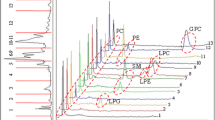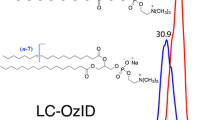Abstract
Phospholipids (PL) are increasingly analyzed by matrix-assisted laser desorption/ionization time-of-flight (MALDI-TOF) mass spectrometry (MS). As in the case of polar molecules, however, the careful selection of the matrix is crucial for optimum results. 9-Aminoacridine (9-AA) was recently suggested as the matrix of choice to analyze PL mixtures because of (a) the improved sensitivity and (b) the reduction of suppression effects compared to other matrices. However, the distinction of phosphatidylcholine (PC) and phosphatidylethanolamine (PE) in the negative ion mode is obscured as PC is also detectable as –CH +3 ion if 9-AA is used as matrix. This may result in the erroneous assignment of PC as a PE species. Using an organic extract from hen egg yolk as example it will be shown that the contribution of PC must be taken into consideration if the negative ion mass spectra are used to evaluate the fatty acyl compositions of PE mixtures. 9-AA can as well be used in hyphenated thin-layer chromatography (TLC)-MALDI-TOF MS where PC and PE are chromatographically well separated for unequivocal assignments.

Comparison of negative ion MALDI-TOF mass spectra of isolated 1-palmitoyl-2-oleoyl-sn-phosphatidylcholine (POPC) and 1-palmitoyl-2-oleoyl-sn-phosphatidylethanolamine (POPE) using either DHB (blue) or 9-AA (red) as matrix. The spectra differ significantly as a function of the matrix used. In case of 9-AA, POPC is detectable as negative ion subsequent to the loss of a -CH3 group, which complicates peak assignments when complex mixtures are analyzed






Similar content being viewed by others
References
Fuchs B, Schiller J (2009) Lysophospholipids: their generation, physiological role and detection. Are they important disease markers? Mini-Rev Med Chem 9:368–378
Peterson BL, Cummings BS (2006) A review of chromatographic methods for the assessment of phospholipids in biological samples. Biomed Chromatogr 20:227–243
Watson AD (2006) Thematic review series: systems biology approaches to metabolic and cardiovascular disorders. Lipidomics: a global approach to lipid analysis in biological systems. J Lipid Res 47:2101–2111
Wenk MR (2005) The emerging field of lipidomics. Nat Rev Drug Discov 4:594–610
Pulfer M, Murphy RC (2003) Electrospray mass spectrometry of phospholipids. Mass Spectrom Rev 22:332–364
Schiller J, Süß R, Arnhold J, Fuchs B, Leßig J, Müller M, Petković M, Spalteholz H, Zschörnig O, Arnold K (2004) Matrix-assisted laser desorption and ionization time-of-flight (MALDI-TOF) mass spectrometry in lipid and phospholipid research. Prog Lipid Res 43:449–488
Schiller J, Süß R, Fuchs B, Müller M, Zschörnig O, Arnold K (2007) MALDI-TOF MS in lipidomics. Front Biosci 12:2568–2579
Puolitaival SM, Burnum KE, Cornett DS, Caprioli RM (2008) Solvent-free matrix dry-coating for MALDI imaging of phospholipids. J Am Soc Mass Spectrom 19:882–886
Murphy RC, Hankin JA, Barkley RM (2009) Imaging of lipid species by MALDI mass spectrometry. J Lipid Res 50:S317–S322
Hillenkamp F, Peter-Katalinić J (2007) MALDI MS - A practical guide to instrumentation, methods and application. Wiley, Weinheim
Schiller J, Süß R, Fuchs B, Müller M, Petković M, Zschörnig O, Waschipky H (2007) The suitability of different DHB isomers as matrices for the MALDI-TOF MS analysis of phospholipids: which isomer for what purpose? Eur Biophys J 36:517–527
Stubiger G, Belgacem O (2007) Analysis of lipids using 2,4,6 trihydroxy-acetophenone as a matrix for MALDI mass spectrometry. Anal Chem 79:3206–3213
Estrada R, Yappert MC (2004) Alternative approaches for the detection of various phospholipid classes by matrix-assisted laser desorption/ionization time-of-flight mass spectrometry. J Mass Spectrom 39:412–422
Li YL, Gross ML, Hsu FF (2005) Ionic-liquid matrices for improved analysis of phospholipids by MALDI-TOF mass spectrometry. J Am Soc Mass Spectrom 16:679–682
Vaidyanathan S, Goodacre R (2007) Quantitative detection of metabolites using matrix-assisted laser desorption/ionization mass spectrometry with 9-aminoacridine as the matrix. Rapid Commun Mass Spectrom 21:2072–2078
Sun G, Yang K, Zhao Z, Guan S, Han X, Gross RW (2008) Matrix-assisted laser desorption/ionization time-of-flight mass spectrometric analysis of cellular glycerophospholipids enabled by multiplexed solvent dependent analyte-matrix interactions. Anal Chem 80:7576–7585
Astigarraga E, Barreda-Gómez G, Lombardero L, Fresnedo O, Castaño F, Giralt MT, Ochoa B, Rodríguez-Puertas R, Fernández JA (2008) Profiling and imaging of lipids on brain and liver tissue by matrix-assisted laser desorption/ionization mass spectrometry using 2-mercaptobenzothiazole as a matrix. Anal Chem 80:9105–9114
Marto JA, White FM, Seldomridge S, Marshall AG (1995) Structural characterization of phospholipids by matrix-assisted laser desorption/ionization Fourier transform ion cyclotron resonance mass spectrometry. Anal Chem 67:3979–3984
Zirrolli JA, Clay KL, Murphy RC (1991) Tandem mass spectrometry of negative ions from choline phospholipid molecular species related to platelet activating factor. Lipids 26:1112–1116
Jaskolla T, Fuchs B, Karas M, Schiller J (2009) The new matrix 4-chloro-alpha-cyanocinnamic acid allows the detection of phosphatidylethanolamine chloramines by MALDI-TOF mass spectrometry. J Am Soc Mass Spectrom 20:867–874
Schiller J, Süß R, Petković M, Zschörnig O, Arnold K (2002) Negative-ion matrix-assisted laser desorption and ionization time-of-flight mass spectra of complex phospholipid mixtures in the presence of phosphatidylcholine: a cautionary note on peak assignment. Anal Biochem 309:311–314
Fuchs B, Süß R, Nimptsch A, Schiller J (2009) Matrix-assisted laser desorption and ionization time-of-flight mass spectrometry (MALDI-TOF MS) directly combined with thin-layer chromatography (TLC)—a review of the current state. CHROMATOGRAPHIA 69:95–105
Fuchs B, Schiller J, Süss R, Schürenberg M, Suckau D (2007) A direct and simple method of coupling matrix-assisted laser desorption and ionization time-of-flight mass spectrometry (MALDI-TOF MS) to thin-layer chromatography (TLC) for the analysis of phospholipids from egg yolk. Anal Bioanal Chem 389:827–834
Bligh EG, Dyer WJ (1959) A rapid method of total lipid extraction and purification. Can J Biochem Physiol 37:911–917
White T, Bursten S, Frederighi D, Lewis RA, Nudelman E (1998) High-resolution separation and quantification of neutral lipid and phospholipid species in mammalian cells and sera by multi-one-dimensional thin-layer chromatography. Anal Biochem 10:109–117
Fuchs B, Schober C, Richter G, Süss R, Schiller J (2007) MALDI-TOF MS of phosphatidylethanolamines: different adducts cause different post source decay (PSD) fragment ion spectra. J Biochem Biophys Methods 70:689–692
Fuchs B, Schiller J, Süß R, Nimptsch A, Schürenberg M, Suckau D (2009) Capabilities and disadvantages of combined matrix-assisted laser-desorption/ionization time-of-flight mass spectrometry (MALDI-TOF MS) and high-performance thin-layer chromatography (HPTLC): analysis of egg yolk lipids. J Planar Chromatogr 22:35–42
Gidden J, Liyanage R, Durham B, Lay JO Jr (2007) Reducing fragmentation observed in the matrix-assisted laser desorption/ionization time-of-flight mass spectrometric analysis of triacylglycerols in vegetable oils. Rapid Commun Mass Spectrom 21:1951–1957
Petković M, Schiller J, Müller M, Süß R, Arnold K, Arnhold J (2009) Detection of adducts with matrix clusters in the positive and negative ion mode MALDI-TOF mass spectra of phospholipids. Z Naturforsch 64B:35–42
Cevć G (1993) Phospholipid handbook. Marcel-Dekker, New York
DeLong CJ, Baker PR, Samuel M, Cui Z, Thomas MJ (2001) Molecular species composition of rat liver phospholipids by ESI-MS/MS: the effect of chromatography. J Lipid Res 42:1959–1968
Schiller J, Süß R, Petković M, Hilbert N, Müller M, Zschörnig O, Arnhold J, Arnold K (2001) CsCl as an auxiliary reagent for the analysis of phospholipid mixtures by matrix-assisted laser desorption and ionization time-of-flight mass spectrometry (MALDI-TOF MS). Chem Phys Lipids 113:123–131
Fuchs B, Schiller J, Süß R, Zscharnack M, Bader A, Müller P, Schürenberg M, Becker M, Suckau D (2008) Analysis of stem cell lipids by offline HPTLC-MALDI-TOF MS. Anal Bioanal Chem 392:849–860
Petković M, Schiller J, Müller M, Benard S, Reichl S, Arnold K, Arnhold J (2001) Detection of individual phospholipids in lipid mixtures by matrix-assisted laser desorption/ionization time-of-flight mass spectrometry: phosphatidylcholine prevents the detection of further species. Anal Biochem 289:202–216
Schiller J, Müller K, Süß R, Arnhold J, Gey C, Herrmann A, Leßig J, Arnold K, Müller P (2003) Analysis of the lipid composition of bull spermatozoa by MALDI-TOF mass spectrometry—a cautionary note. Chem Phys Lipids 126:85–94
Staab HA, Saupe T (1988) "Proton Sponges" and the geometry of hydrogen bonds: aromatic nitrogen bases with exceptional basicities. Angew Chem Int ed 27:865–879
Shroff R, Svatoš A (2009) 1, 8-Bis(dimethylamino)naphthalene: a novel superbasic matrix for matrix-assisted laser desorption/ionization time-of-flight mass spectrometric analysis of fatty acids. Rapid Commun Mass Spectrom 23:2380–2382
Acknowledgments
This work was supported by the German Research Council (DFG Schi 476/5-1, TR 67 subproject A2 and Fu 771/1-1) as well as the Federal Ministry of Education and Research (BMBF Grant 0313836).
We thank Dr. Thorsten Jaskolla (University of Frankfurt) for discussions and many useful hints on optimum matrix selection.
Author information
Authors and Affiliations
Corresponding author
Rights and permissions
About this article
Cite this article
Fuchs, B., Bischoff, A., Süß, R. et al. Phosphatidylcholines and -ethanolamines can be easily mistaken in phospholipid mixtures: a negative ion MALDI-TOF MS study with 9-aminoacridine as matrix and egg yolk as selected example. Anal Bioanal Chem 395, 2479–2487 (2009). https://doi.org/10.1007/s00216-009-3032-1
Received:
Revised:
Accepted:
Published:
Issue Date:
DOI: https://doi.org/10.1007/s00216-009-3032-1




